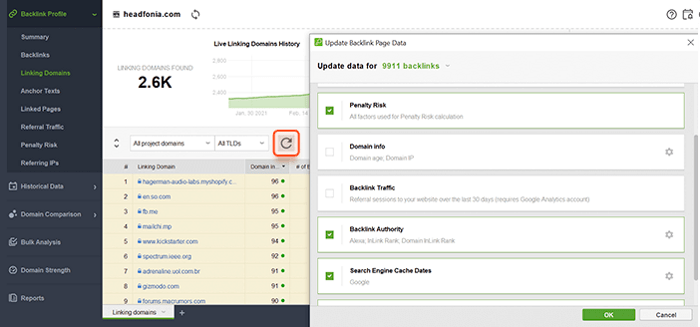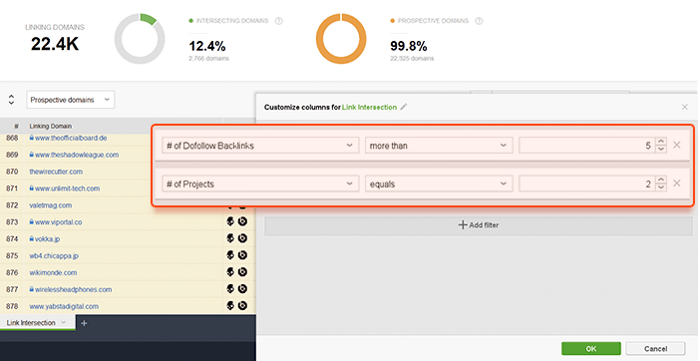
How to Find Competitor’s Backlinks in 4 Simple Steps

When looking for ways to improve organic search engine rankings in just about any industry, the fact is that there are still only two primary ranking factors that search engines like Google give priority to: great content and strong backlink profile.
Neither of these aspects of an SEO campaign are necessarily considered "difficult" to do. However, there seems to be a lot of confusion when it comes to identifying the best way to go about these two tactics, especially link building.
Today, we're going to focus on backlinks and how to acquire some of the most impactful inbound links using SEO Powersuite. But before we get into the 4 simple steps that can be used for gaining competitors' backlinks, we have to address a common question that comes up all too often in the SEO industry:
Isn't Link Building Dead?
Absolutely not. And here's why:
1) The Search Engine Ranking Factors Report by Moz proved that the two most influential factors Google is using to rank websites the way they do are directly related to backlinks.
2) Doing a simple Google search for a term like "link building case studies" will provide plenty of recent examples of the impact that backlinks have had for the websites being considered.
3) Many companies spend thousands of dollars each month paying for link building services, or buying backlinks out right. That doesn't mean that this is the best or safest method of link acquisition, but the fact that it's happening says a lot in itself.
4) How about empirical proof? Take a few moments to identify 5-10 keywords that you would love to rank for on page one of Google, and take note of the top 3 or top 5 ranking sites for each of those terms. From there, analyze if they have backlinks pointing to both their domain and the ranking page.
You can do this with the click of a button using SEO PowerSuite's Rank Tracker (download the free version here). Just create a project for your site specifying the site's URL and your 5-10 target keywords, switch to the Keyword Difficulty tab in the lower part of your Rank Tracker screen, and hit Update.
For example, it took about 2 minutes to get that data for the keyword "search engine optimization" below:
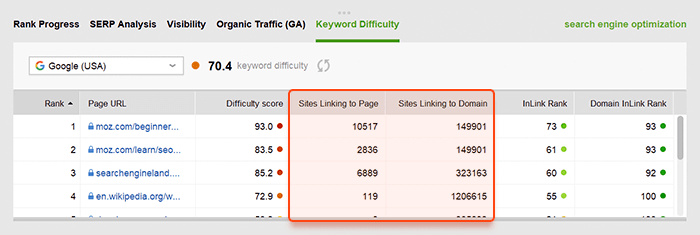
I'm pretty sure you'll find that the sites' number of links has a strong correlation to their rankings. If you'd like to see specifically which links a given domain or page has, SEO SpyGlass (also part of the SEO PowerSuite toolkit) will allow you to identify the individual backlinks any website or webpage has.
Those 4 quick facts prove link building isn't dead; of course there are also other factors to back the statement, but let's not turn this into a discussion of whether or not backlinks are important.
Apart From SEO, How Does Link Building Help?
Not only do backlinks play a massive role when it comes to ranking in the search engines, they also have value outside of the benefits that come from organic rankings.
1) Backlinks can bring in highly targeted, valuable traffic from referring websites.
2) Backlinks are great for branding in the sense that they get your target audience familiar with seeing your brand associated with the products or services that they are looking for.
3) Backlinks give the impression that you're an authority in your given industry.
Bonus: It's safe to say that in most industries online, including yours, high ranking websites are not actively implementing the link building strategies highlighted below. What that means is you can separate yourself from your competitors and have an advantage if you decide to apply 4 simple tips of the backlink strategy outlined below.
So, What Backlinks Are The Best To Pursue?
There are a lot of options to choose from when answering the question where to get your best backlinks; but the most obvious and impactful, which ironically are the most overlooked, are competitor backlinks.
Simply put, aside from the content and functionality of the highest ranking websites in the industry you might be trying to compete in, backlinks are often the differentiator between a site ranking #1 vs #8 in the SERPs (search engine result pages). With that being the case, acquiring the same backlinks that not only the #1 ranking site has, but that all the top 10 websites have, can result in rapid ranking improvements for your website (literally from one day to the next).
How to Acquire Your Competitors' Backlinks In 4 Steps
1. Identify Your Competitors in Organic Search.
What Does This Mean?
When it comes to SEO, oftentimes a website owner thinks that their competitors are some of the largest brands in their industry, but that's not always the case. For example, think of a keyword like "sports drinks". It would be easy to assume that the top SEO competitors would be traditional competitors in the niche Gatorade, Powerade, VitaminWater, Red Bull, etc. However, none of those brands rank in top 10 for that keyword, and Gatorade is the only company of the 4 mentioned above that rank in the top 20.
So if you're trying to get the most impactful backlinks to help rank on page one for a term, you need to identify your true competitors in the search engine, not the largest brands in your industry.
How Do You Find Your SEO Competitors?
1) To find out who your top competitors are, choose 10-20 keywords that you would like to rank on page 1 for.
(For the purpose of this guide, I'm going to focus on the wireless/bluetooth earphones keyword theme.)
best bluetooth headphones
best wireless bluetooth headphones
best wireless headphones
bluetooth headphones
bluetooth wireless headphones
wireless bluetooth headphones
wireless earphones
wireless headphones
wireless headphones for tv
wireless tv headphones
2) Create a new project for your website with Rank Tracker, and put in your website address.
(We're going to choose to work with a random earphone blog we have no affiliation with that we found online: headfonia.com.)
Tip: No need to add a Google Analytics or Search Console for this step, just click Next.
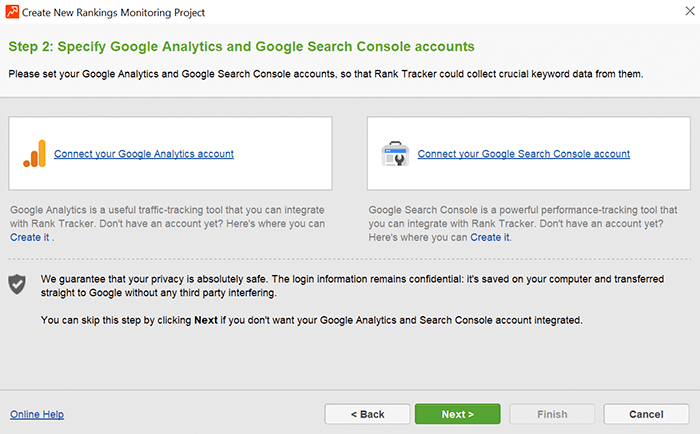
3) Add your 10 target keywords you've identified above, and click Next once more.
4) Select your preferred search engine (for this example, we will focus on Google, but you can add whatever local search engine you want). Then click Finish.
Tip: If you click Next at Step 4 above, Rank Tracker will check the rankings for your website with the keywords you've entered. At this point we're not trying to check the rankings, we're just trying to identify our SEO competitors for our target keywords.
5) You should now see the keywords you entered on Rank Tracker's main Target Keywords screen. Now, to find out which competitors rank for this selection of keywords, go to Preferences > Competitors.
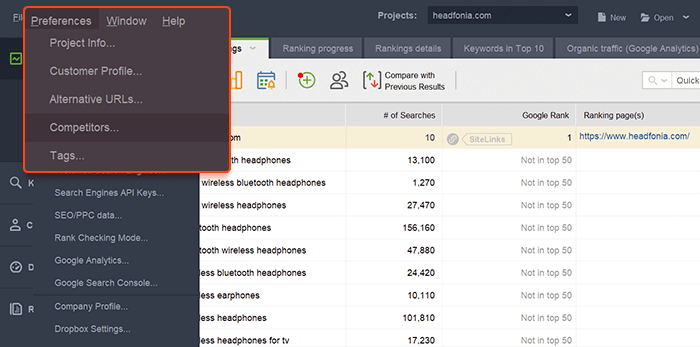
6) The competitor management screen will pop up. Now to find out who your SEO competitors are for Google, select the Suggest button in the top middle of the screen.
7) All 10 of your target keywords should automatically be loaded. If you want to do more than 10, or remove some, you can make that adjustment right here on this page. Click Next.
8) The target search engine should already be present from the option you made at Step 3, so click Next again.
Rank Tracker will now search Google for all of the keywords you entered, and will search the top 30 websites that rank well in Google for your selected keywords.
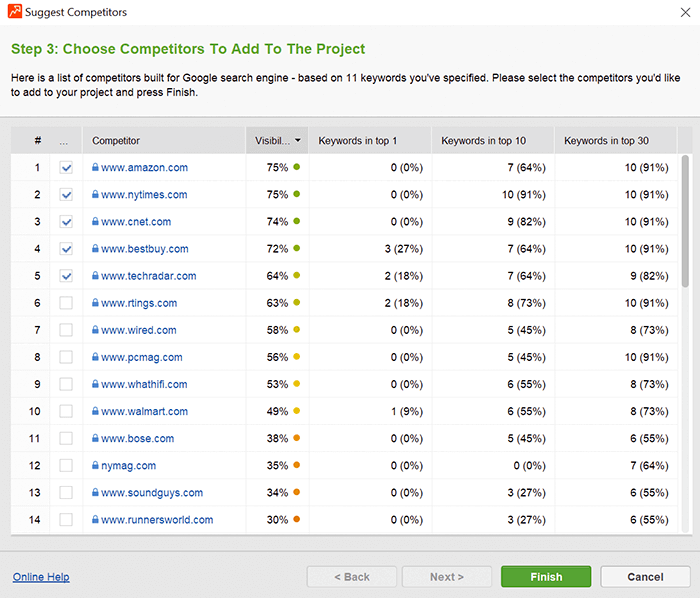
9) Now that you have a list of the top 30 competitors for the target keywords you've identified, you can clearly know which websites are your competitors in the organic search.
Tip: Some link building experts would not consider the brands shown above like BestBuy, Amazon, PCMag, Cnet, etc as true SEO competitors since they are very large websites that sell much more than just audio equipment like earphones. For that reason, it might be best to focus your backlink competitive analysis on companies and websites that are specific to earphones… such us: Sennheiser, JBL, Bose, SkullCandy, BeatsByDre, etc.
2. Identify The Backlinks Your SEO Competitors Have.
Now we will use SEO SpyGlass to find out the backlinks that some of these brands have that we could actively pursue. You can download it as part of the SEO PowerSuite toolkit here.
1) Create a new project in SEO SpyGlass and enter your own website's URL. Put a tick next to Enable expert options to configure additional settings for your link profile audit. Then click Next.
2) Make sure SEO PowerSuite Link Explorer is selected as your preferred backlink source, and click Next.
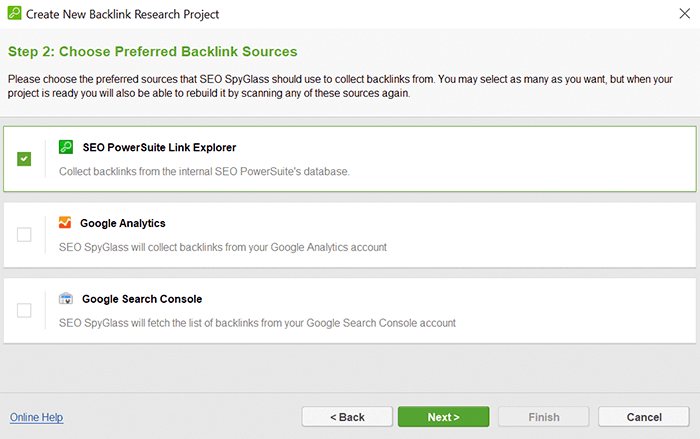
3) Select whether or not you want a limit to the total number of backlinks that the software provides. The max is 250,000. For this example, we will not set a limit.
Additionally, you can select how many backlinks come from one competitor's domain you're interested in having.
Tip: If a website has many sitewide links, you can end up having 100s or 1,000s of backlinks added to the SEO SpyGlass report from just one website linking to your domain. For that reason, it's always a good idea to use this option when you're not trying to analyze all of the different pages from one domain that is linking to your website. For this example, we will leave the default number of 10 backlinks per domain.
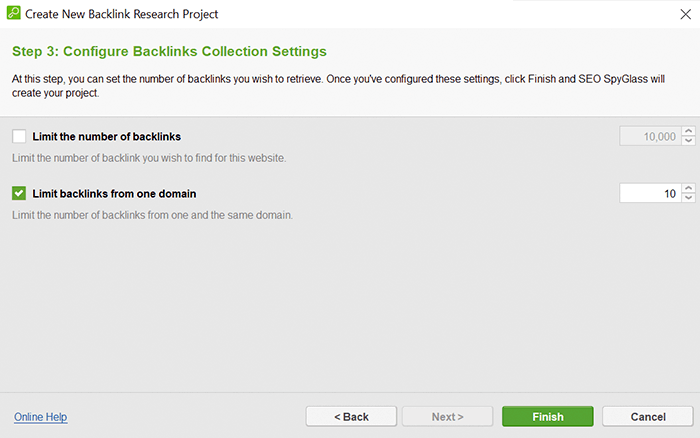
4) SEO SpyGlass will now search through its database for all of the backlinks that the given domain has; this is based off of the domain name you entered above. When SEO SpyGlass is done building the backlink repository, you'll see a summary of the backlinks your website has.
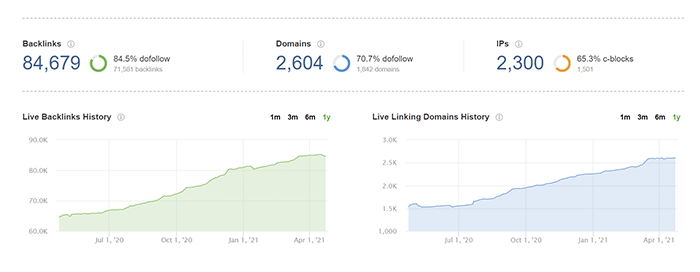
5) Go to the Domain Comparison module. A Domains to Compare pop-up box will appear. Enter the URLs of each of the SEO competitors you've identified, one by one, and click OK to check the competitors’ link profiles.
Tip: With the Enterprise version of SEO SpyGlass, you can compare monitor competitor backlinks for up to 10 domains which is something that at this time no other backlink software does nearly as accurately and efficiently.
The backlink checker tool will now automatically create projects for each competitor you specified, and put together a comparison table on the sites' links profiles. From this report you will grasp how strong your competitors’ backlink profiles are.
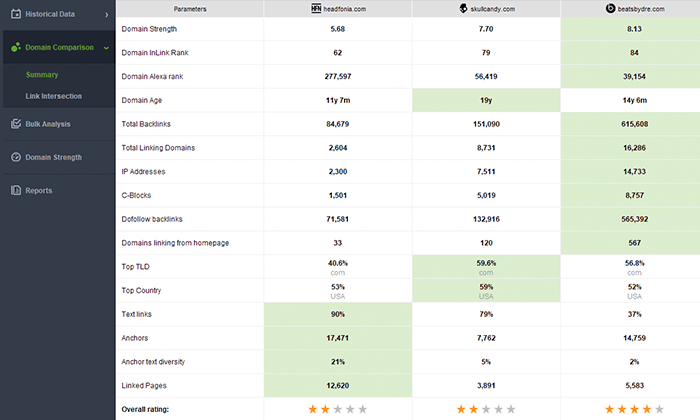
3. Identify Websites That Are Likely To Link To Your Website.
Now that you have used SEO SpyGlass to create a backlinks report for your website and specified your main SEO competition, you can find the domains that are likely to link to your site by identifying the ones that have linked to at least 2 of your competitors.
Doing this will enable you to start contacting the websites that clearly link to more than one of your competitors, which increases the likelihood that those websites would be willing to create new backlinks to your site as well since it's related to the same industry.
Below are the steps needed to identify the backlinks that your competitors share.
1) Click on Link Intersection on the left side of the main navigation pane (under the Domain Comparison module).
2) The link-intersect tool will now collect detailed backlink data on the sites you specified, so you may need to hang on a few minutes. When it's done, you will find all of the different websites linking to either your website, or those of your competitors. However, the goal here is to identify the websites that are likely to link to your website due to the fact that they already link to your competitors' websites.
To accomplish that, select the drop down-menu in the top left corner of the workspace showing All backlinks and switch to show only Prospective domains.
Tip: This will show you a list of all the domains linking to your competitors' websites. With a bit of research, using the SEO SpyGlass software we were able to find 1515 different websites that link to at least 2 of the best ranking websites in the earphones industry. Imagine how many websites we might have found if we added 5 or even 10 competitors!
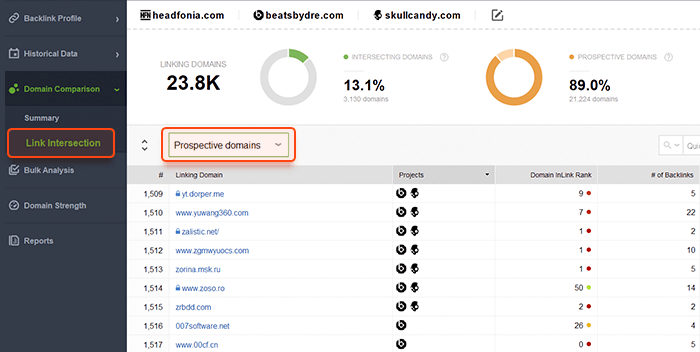
3) Analyze how valuable any of the links from these competitor backlinks might be by editing the current workspace to add metrics that you feel are important to determine the strength of a domain.
Tip: Some of the most common metrics used to determine the value of a link coming from any given website are domain age, whether the backlinks are dofollow or nofollow, how many of the site's pages are indexed in search engines like Google/Yahoo, how many social mentions or signals the domain has on social media platforms like Facebook, Twitter, LinkedIn, and Domain Authority (for this factor, I need to add MOZ API, so I’ll skip it in this use case).
For analyzing backlinks, right-click on any of the column headers in this the Link Intersection workspace, and edit or add the metrics that you'd like to use to determine the possible value of a link to the main viewing pane.
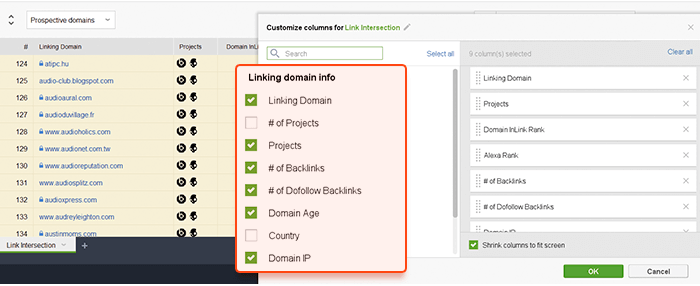
Then go to Backlink Profile > Linking Domains in the left-hand navigation pane in your project. In the Linking Domains view, you can select the specific metrics that help assess the linking domains’ value. Right-click on any column’s header and add the factors such as Domain Age, Penalty Risk, Popularity in social media.
Next, hit the Update Factors button in the top middle of the workspace of your project, the data will be loaded in the backlink viewing pane in the middle of the screen.
From there you can return to the Link Intersection pane for the project you created for your website where the link metric factors that you selected will populate in the viewing pane of the Link Intersection area.
Tip: To check the link metrics that you would like to use to determine the value of any of the domains linking to your competitors, you will need to open each of the projects (for your own website as well as your competitors) in the drop-down project menu in the top right corner, and go to Backlink Profile > Linking Domains in the left-hand navigation pane in each project.
4) Select the backlink domains in the Link Intersection viewing pane that you would like to contact to inquire about getting a link for your website. Once you have selected the desired domains that seem to be your potential link opportunities, you can copy and paste all of that data to a spreadsheet to have the entire list of sites you would like to contact (or have the results exported in an CSV file).
In fact, I applied the dofollow link filter at the very start, leaving domains sending more than 5 dofollow backlinks, and added one more filter to have only those backlinks that link to both competitors in my project. In the results, I have around 900 domains where I can request a backlink to this site.
And now to the fun part: how do you go about inquiring to obtain a backlink from all of these domains? What if there are 1515 of them?
4. Inquire About Getting A Backlink To Your Website.
In our example we now have more than a thousand websites that we've identified as backlink opportunities would like to contact due to the fact that each of them link to at least 2 of the competitors we've identified. Now we will need to get the contact information to reach out to those websites about getting a link for our website.
What's the best way to do this?
SEO PowerSuite's LinkAssistant software. Following the steps below, you'll see how you can use this powerful tool to get contact information for a large percentage of these thousand domains that we've identified as backlink opportunities in this example.
1) Create a new project for your website in LinkAssistant.
2) Switch to the Prospects module, you'll notice a green button at the top left that says Add; click that button.
3) A new window will pop up. Copy/paste all of the backlink domains you selected at Step 3 in SEO SpyGlass into the empty box:
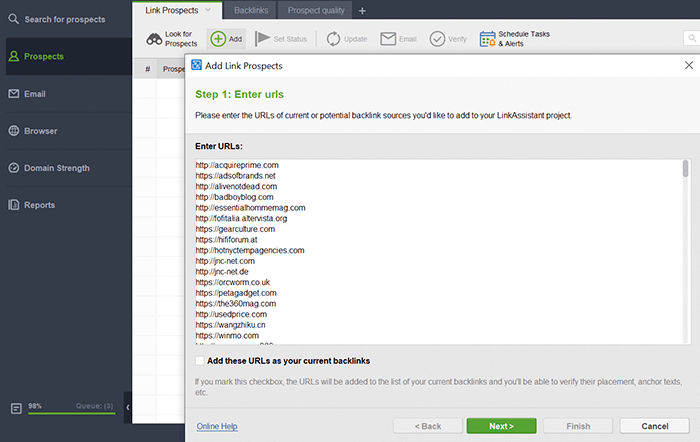
Leave the Add these URLs as your current backlinks box unchecked and click Next.
4) The prospecting tool will show the initial status of your backlink prospects (‘Send link request mail’); you can also add a tag to them for easier management later on. Let’s call it, for example, ‘competitor backlinks’. Click Next, and select to acquire only Contact info, then hit Finish.
LinkAssistant will then try to find a contact email address for each of the domains one by one. Once it's finished, the software will allow you to select which domains you would like to keep and add to the the Link Prospects workspace of LinkAssistant. Make your selections and click Finish.
5) You should then see all of the prospect domains that you've selected listed in the main workspace, along with an email address if LinkAssistant was able to find one. The domains will have the status ‘Send email’ meaning they are your backlink opportunities and you are about to request them to build some new backlinks to your site.
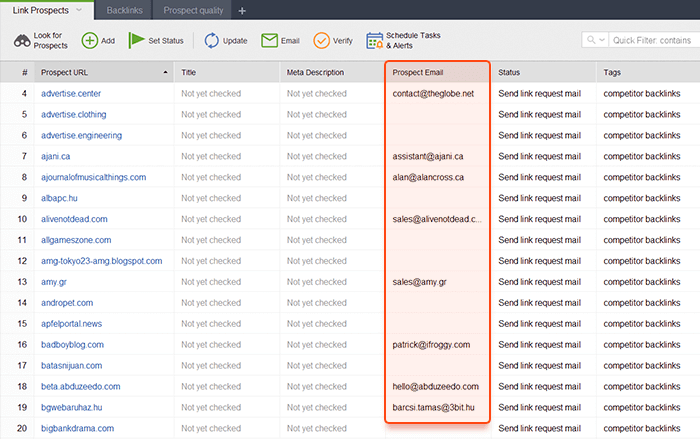
In less than 5 minutes, LinkAssistant was able to find an email address for 330 of the prospect domains added to this project. The outreach tool allows sending bulk email correspondence with personalized elements, using ready-made templates.
Select the prospects whom you would like to request for a backlink, right-click and select Send Email(s) To Selected Partner(s). Using LinkAssistant's internal browser, you can also try to manually find email addresses on the websites that we've identified as linking to your competitors. For the websites where no email address was found but that use contact forms, you can also save those forms to later visit them to email them about possibly getting a backlink for your website.
6) You're done! Now it's time to start emailing the link prospects that are playing a large role in how your competitors are ranking in your specific industry for the keywords you're targeting.
Tip: LinkAssistant has a powerful yet simple way of sending emails in an organized manner. For step-by-step instructions on how easy this can be, take a look at video #3 found here (under the Link Building section). Otherwise, you can copy/paste the email addresses found and reach out to the website owners using whatever method or platform you prefer.
This might seem like quite a process to get a clear understanding of not only who your top SEO competitors are, what backlinks they have that are contributing to their rankings, how to identify which sites might be more agreeable to linking to your site, and finally… how to simply ask for a link.
Nothing about what was said above was particularly difficult or complex, but it is definitely a process. Of course, there are other ways to find competitor backlinks, but doing so in this manner will provide you with all the backlink opportunities that you'll ever need, no matter what industry you're in. Since the early 2000s, I've personally tried just about every method of acquiring competitor backlinks… and this method outperforms them all.
Level Up Your Link-Building with Advanced Techniques
Winning competitor backlinks is a surefire way to start growing your backlink profile from scratch. For advanced link-building, there are some other techniques that proved to be effective one day or another and can be incorporated into your links strategy:
-
Webmasters should watch out for broken links because there is this awesome broken link building: you find more backlink opportunities through auditing your competitors’ websites for linked 404 pages.
-
Sometimes you may steal links with the skyscraper link building technique: find top-ranking pages in your niche, create a better copy, and ask the webmasters of the linking sites to hit you with a backlink because your content is so much better.To check an individual popular page you’ve chosen as your skyscraper target, run it through the free online backlink checker to review all its backlinks.
-
Check for link penalties: though nowadays it is a rare case that you may get exposed to Penguin penalties, the bad backlink checker feature is helpful when acquiring a new domain. You can set to receive alerts when you have too many links appearing at a time from a single domain. This may indicate these are low-quality or paid links that may look suspicious to Google and lead to a link penalty.
-
Even if you are confident at your first positions in Google search results page, monitor competitors' backlinks by history to know whether they have had a considerable influx of backlinks recently, else you risk to stay behind the competition one day. If you noticed that some of your competitors are getting higher in organic results, in addition to your content optimization, think of putting more effort into links. For this purpose, SEO SpyGlass has the Historical Data module where you can sort the fresh and lost links and investigate the reason behind such changes in link profiles.
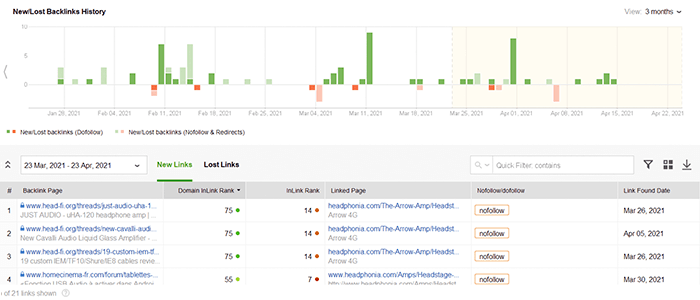 Peep into backlink history data.
Peep into backlink history data. -
Track competitor brand mentions to hack their marketing strategy or to adjust your reputation management SEO against your industry competition. For this purpose, use the Awario online social listening tool: set up alerts to track where your brand and your competitors are mentioned on the web and in social media.
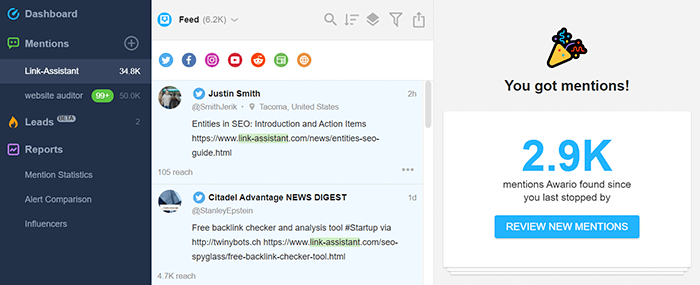 Linked and unlinked mentions of a brand.
Linked and unlinked mentions of a brand.
Now it's your turn!
Do you have any questions about any of the steps above? Are there any steps in this article you might do differently that you'd like to share? What is your proven technique to create new inbound links? As always, we're looking for a lively discussion in the comments below.

